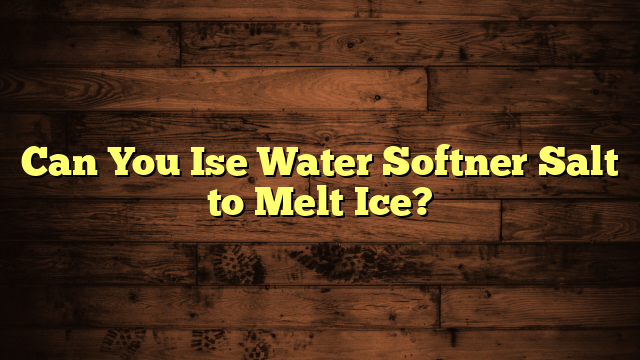Can You Ise Water Softner Salt to Melt Ice?
You might be wondering if water softener salt can serve as an effective solution for melting ice during those harsh winter months. Since it contains sodium chloride, it does have the potential to disrupt ice's molecular structure and create a brine that absorbs heat. However, before you start pouring it on your driveway, it's important to think about its effectiveness in extremely low temperatures and the potential environmental impacts. What factors should you keep in mind to guarantee you're making the best choice?
Key Takeaways
- Yes, water softener salt can be used to melt ice due to its sodium chloride content, which lowers the freezing point of water.
- It is less corrosive than traditional de-icers, making it safer for surfaces and the environment.
- The effectiveness of water softener salt decreases in extremely cold temperatures compared to traditional ice melts.
- Excessive application can harm soil health and freshwater ecosystems, so use sparingly and follow local regulations.
- Monitor ice conditions after application and reapply as needed for optimal results.
Understanding Water Softener Salt
Understanding water softener salt begins with recognizing its primary purpose: to exchange ions and reduce water hardness. When you use a water softener, the device draws water through a resin bed, where the salt types—typically sodium chloride or potassium chloride—replace calcium and magnesium ions with sodium ions. This process effectively softens the water, making it gentler on your plumbing and appliances.
Water hardness can lead to scale buildup, which not only clogs pipes but can also decrease the lifespan of your water heater and other devices. By using water softener salt, you can prevent these issues, ensuring your home runs smoothly.
There are several salt types available, including evaporated salt, solar salt, and rock salt, each with its pros and cons. Evaporated salt, for instance, is the purest form, while solar salt is more economical but may contain some impurities. Understanding these differences helps you make informed choices about which salt type to use for your specific water softener system.
How Ice Melting Works
Ice melting occurs through a process called freezing point depression, where substances, such as salt, lower the temperature at which water freezes. When you spread salt on ice, it disrupts the ice formation by breaking the bonds between water molecules, making it harder for them to stay frozen.
This means the melting point of the ice decreases, allowing it to turn into liquid water even when temperatures remain below 32°F (0°C).
Here's how it works:
- Salt dissolves in water, creating a brine solution.
- The brine lowers the freezing point, meaning ice can melt at lower temperatures.
- Heat transfer occurs, as the saltwater absorbs heat from the surroundings.
- Liquid water forms, further preventing ice from refreezing.
- This cycle continues, effectively clearing surfaces of ice.
Effectiveness of Water Softener Salt
When it comes to melting ice, water softener salt can be surprisingly effective, but it's not always the best choice. The effectiveness of this salt largely depends on its composition and the water chemistry in your area.
Water softener salt typically contains sodium chloride, a common salt type that can lower the freezing point of water. However, its melting capabilities may not be as potent as other ice-melting salts like magnesium chloride or calcium chloride.
One reason for this is that water softener salt often contains impurities that can affect its performance. Furthermore, the concentration of salt in your solution plays an essential role. If you're using water softener salt in a diluted form, it may not generate enough heat to melt ice efficiently.
Moreover, consider the environmental impact of using this type of salt. While it may help with melting ice, it can also lead to increased sodium levels in soil and waterways.
Ultimately, while water softener salt can work in a pinch, knowing the specific salt types and their effectiveness will help you make a more informed decision when tackling icy conditions.
Benefits of Using Water Softener Salt
Using water softener salt for melting ice offers several benefits that can make it a practical choice in certain situations. One of the most significant advantages is its health benefits. Unlike some chemical de-icers, water softener salt is less harmful to pets and plants, making it a safer option for your environment.
Additionally, you'll find that using water softener salt is quite convenient. It's readily available and often less expensive than traditional ice melt products.
Here are some key benefits to evaluate:
- Eco-Friendly: It's less damaging to the ecosystem compared to harsher chemicals.
- Effective: Water softener salt can effectively lower the freezing point of water, helping to melt ice.
- Less Corrosive: It's gentler on surfaces like concrete and metal, reducing wear and tear.
- Easy to Store: You can keep it with your regular water softening supplies, ensuring you're always prepared for winter.
- Multi-Purpose: Beyond melting ice, you can use it for other household needs.
Potential Drawbacks to Consider
While using water softener salt for melting ice might seem like a practical choice, there are some potential drawbacks you should consider.
It's important to think about its environmental impact, how it compares in effectiveness to regular salt, and whether it's truly cost-efficient for your needs.
Weighing these factors can help you make a more informed decision before you grab that bag of salt.
Environmental Impact Concerns
Water softener salt may seem like a convenient solution for melting ice, but its environmental impact raises several concerns.
Using this type of salt can lead to issues that may not be immediately apparent. You might be surprised to learn that while it works effectively at melting ice, it can also contribute to chemical runoff, which can harm local ecosystems.
Consider these potential drawbacks:
- Soil degradation: Excessive salt can alter soil composition, affecting plant growth.
- Water quality: Salt runoff can contaminate local water sources, impacting drinking water.
- Wildlife harm: Increased salinity levels can harm aquatic life and disrupt natural habitats.
- Regulatory issues: Some areas have environmental regulations that restrict salt usage due to its harmful effects.
- Long-term consequences: Continuous use may lead to persistent environmental issues.
Before deciding to use water softener salt for ice melting, it's important to weigh these impacts.
Exploring alternative de-icing methods might be more beneficial for the environment, ensuring you're not contributing to long-term ecological damage.
Effectiveness Compared to Salt
When considering ice-melting options, the effectiveness of water softener salt compared to traditional rock salt is worth examining. While both can tackle ice, they differ in performance and suitability. Here's a comparative analysis of their effectiveness measures:
| Type of Salt | Effectiveness |
|---|---|
| Water Softener Salt | Lower melting efficiency; works best in mild temperatures. |
| Traditional Rock Salt | Higher melting efficiency; effective even in severe cold. |
Water softener salt contains additives that may reduce its melting power compared to rock salt. It's generally less effective in extremely low temperatures, which can be a significant drawback if you live in a colder climate. Moreover, it may require more frequent applications, making it less convenient.
On the other hand, rock salt is a tried-and-true option, with a proven track record for melting ice quickly and efficiently. It's designed to lower the freezing point of water, making it a reliable choice during harsh winter conditions. Ultimately, if you're looking for an effective solution to combat ice, rock salt remains the superior choice.
Cost Efficiency Analysis
Reflecting on the effectiveness of ice-melting options, cost efficiency also plays a significant role in your decision-making. When weighing the use of water softener salt for melting ice, you'll want to contemplate a few potential drawbacks that could impact your budget.
Here's a quick cost comparison to keep in mind:
- Price per bag: Water softener salt can be more expensive than traditional rock salt.
- Effectiveness: You might need to use more water softener salt to achieve similar melting results, increasing overall costs.
- Environmental impact: Using excessive salt can lead to soil and waterway damage, potentially incurring future costs for remediation.
- Availability: Depending on where you live, water softener salt mightn't be as readily available, forcing you to pay extra for shipping or travel.
- Long-term effects: If you use it frequently, the cumulative cost may exceed that of standard ice melt products.
Comparison With Traditional Ice Melt
Using water softener salt for melting ice might seem like a convenient option, but it's important to compare it with traditional ice melt products. Traditional ice melts, like calcium chloride or magnesium chloride, are specifically designed for de-icing and usually work faster at lower temperatures. When you're facing a snow-covered driveway, you want something that'll get the job done quickly.
While water softener salt can be an ice melt alternative, its effectiveness is limited, especially in extremely cold conditions.
Plus, safety factors come into play. Some traditional ice melts are formulated to be pet-safe, while water softener salt can be harmful if ingested by pets or humans. The last thing you want is to put your furry friends at risk while trying to clear your walkways.
Moreover, traditional options often contain additives that help prevent corrosion on surfaces, which isn't the case with water softener salt.
When weighing your options, reflect on not just the cost but also effectiveness and safety. You want a solution that works well, protects your loved ones, and keeps your surfaces intact.
Eco-Friendliness of Water Softener Salt
While traditional ice melts have their advantages, you might wonder about the environmental impact of your de-icing choices. When evaluating eco-friendliness, water softener salt stands out due to its unique properties.
It's crucial to acknowledge, however, that while it's generally less harmful than many commercial ice melts, it still has some effects on the environment.
Here are some factors to reflect on:
- Sustainability Practices: Using water softener salt aligns with more sustainable practices compared to harsher chemical alternatives.
- Soil Impact: Excessive salt can harm soil health, so moderation in application is key.
- Waterways: Salt can affect freshwater ecosystems, so check local regulations on its use.
- Plant Life: Plants sensitive to salt may suffer if exposed, especially in gardens and landscapes.
- Biodegradable Alternatives: Exploring biodegradable alternatives can provide eco-friendlier options without sacrificing effectiveness.
Best Practices for Application
When it comes to applying water softener salt for melting ice, timing and technique play essential roles in effectiveness. First, you should apply the salt before the temperature drops too low. This allows it to work more efficiently as it begins to melt the ice.
Spread the salt evenly over the icy areas using a scoop or a salt spreader, ensuring you cover the surface adequately. This helps create a more uniform melting effect.
When you're using application techniques, remember to start with a small amount. You can always add more if needed, but over-applying can damage your surfaces or contribute to environmental issues.
Furthermore, keep safety precautions in mind: wear gloves to protect your hands, and avoid inhaling dust from the salt. If you have pets, be cautious, as salt can irritate their paws.
Lastly, monitor the area after application. If you notice any ice remaining, feel free to reapply the salt as necessary. Following these best practices will help you use water softener salt effectively to keep your walkways safe and ice-free.
Frequently Asked Questions
Can Water Softener Salt Damage Concrete Surfaces When Used for Ice Melting?
Yes, water softener salt can cause concrete damage over time due to its corrosive nature. Instead, consider alternative uses like sand or gravel for ice melting to protect your concrete surfaces from harm.
Is Water Softener Salt Safe for Pets and Plants?
Did you know that 70% of pet owners worry about their pets' safety around chemicals? Water softener salt can harm both pet safety and plant health, so it's best to keep them away from treated areas.
Can I Mix Water Softener Salt With Other Ice Melt Products?
You can mix water softener salt with other ice melt products, but watch for compatibility concerns. Always check effectiveness comparisons to guarantee you're not compromising melting efficiency or harming surfaces in the process.
How Quickly Does Water Softener Salt Start Melting Ice?
You might be surprised, but water softener salt's melting speed isn't as fast as traditional ice melt products. Its effectiveness varies, taking longer to work, especially in extremely cold temperatures. Be patient while waiting for results.
Where Can I Purchase Water Softener Salt for Ice Melting?
You can find water softener salt at local suppliers like hardware stores, garden centers, or big-box retailers. Check online for availability and compare prices to see where to buy the best option near you.
Conclusion
To sum up, using water softener salt for melting ice is a practical option, particularly since sodium chloride can lower water's freezing point. Notably, when applied correctly, it can reduce ice formation by up to 50% compared to untreated surfaces. However, keep in mind the potential environmental impact and lower effectiveness in extreme cold. By following best practices, you can maximize its benefits while minimizing drawbacks, making it a smart choice for seasonal ice management.







